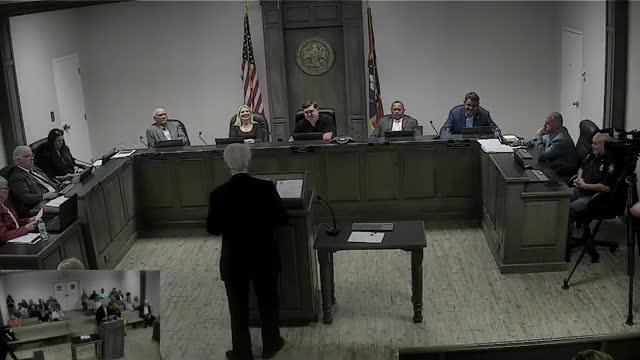Supervisors uphold planning commission denial of proposed 199.5-foot tower near private airstrip
October 13, 2025 | Harrison County, Mississippi
This article was created by AI summarizing key points discussed. AI makes mistakes, so for full details and context, please refer to the video of the full meeting. Please report any errors so we can fix them. Report an error »

The Harrison County Board of Supervisors on Wednesday denied an appeal by Diamond Communications and the tower applicant, upholding the Planning Commission's earlier denial of a variance and conditional-use permit for a proposed 199.5-foot communications tower on a Mississippi Power substation property off Mark West Road.
Diamond Communications's senior vice president of site acquisition, who said the company builds towers for utilities and wireless carriers, told the board the location was chosen because the site has existing fiber and a head-end unit that would tie the structure into Mississippi Power's grid-communications network. The applicant described a self-supporting tower with a 50-by-50-foot fenced compound; Diamond said the tower is engineered with a fall zone certification and that the site would be suitable for co-location.
Opponents, including airport trustee Jimmy Miller and other pilots, told the board the proposed structure would sit directly beneath the private Shade Tree airstrip's traffic pattern and risked interfering with takeoff and landing operations. Miller and other opponents provided enlarged excerpts from the aeronautical chart and said the tower would be inside the airstrip's pattern. Diamond said the Federal Aviation Administration had previously approved the tower height without lighting at approximately 200 feet and that the company had commissioned additional FAA review of private-airstrip flight paths; the company also offered to add lighting or agree to a removal clause if the tower remained unused for a year.
Board discussion focused on whether the applicant had demonstrated the required showing for a setback variance (practical difficulty) and whether the tower would materially affect airport operations. The planning commission had concluded the variance and conditional-use standards were not met. After hearing rebuttal from both sides and additional FAA-related testimony in the record, a supervisor moved to deny the appeal and to uphold the planning commission's denial; the motion was seconded and carried. One board member abstained due to a disclosed employer conflict.
The board did not adopt alternative conditions such as mandatory lighting or a one-year removal requirement as a substitute for the variance. The denial leaves in place the Planning Commission's decision; the applicant may pursue further administrative or legal options available under county ordinance and state law.
Diamond Communications's senior vice president of site acquisition, who said the company builds towers for utilities and wireless carriers, told the board the location was chosen because the site has existing fiber and a head-end unit that would tie the structure into Mississippi Power's grid-communications network. The applicant described a self-supporting tower with a 50-by-50-foot fenced compound; Diamond said the tower is engineered with a fall zone certification and that the site would be suitable for co-location.
Opponents, including airport trustee Jimmy Miller and other pilots, told the board the proposed structure would sit directly beneath the private Shade Tree airstrip's traffic pattern and risked interfering with takeoff and landing operations. Miller and other opponents provided enlarged excerpts from the aeronautical chart and said the tower would be inside the airstrip's pattern. Diamond said the Federal Aviation Administration had previously approved the tower height without lighting at approximately 200 feet and that the company had commissioned additional FAA review of private-airstrip flight paths; the company also offered to add lighting or agree to a removal clause if the tower remained unused for a year.
Board discussion focused on whether the applicant had demonstrated the required showing for a setback variance (practical difficulty) and whether the tower would materially affect airport operations. The planning commission had concluded the variance and conditional-use standards were not met. After hearing rebuttal from both sides and additional FAA-related testimony in the record, a supervisor moved to deny the appeal and to uphold the planning commission's denial; the motion was seconded and carried. One board member abstained due to a disclosed employer conflict.
The board did not adopt alternative conditions such as mandatory lighting or a one-year removal requirement as a substitute for the variance. The denial leaves in place the Planning Commission's decision; the applicant may pursue further administrative or legal options available under county ordinance and state law.
View full meeting
This article is based on a recent meeting—watch the full video and explore the complete transcript for deeper insights into the discussion.
View full meeting
